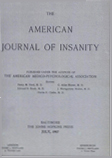HEREDITY RELATIONS IN SCHIZOPHRENIA
Abstract
Statistical evidence and the results of the analyses of individual families in which schizophrenia occurs indicate that heredity is an important factor to be considered in the etiology of schizophrenia.
In a series of 150 unselected cases of schizophrenia there were 117, or 78.01 per cent, that had heredity tainting factors, usually considered as of significance in the heredity of the psychoses.
This is about equal to that found for psychoses in general and considerably greater than that of the non-psychotic, 78.01:67.
It is slightly less than has been found in manic depressive psychoses, 78.01:84.13, and in epilepsy, 78.01:81.26.
The most frequent tainting factor is psychoses. These occur among the mental abnormalities of the antecedents and members of the families in a percentage of 43.22.
This is about three times greater than has been found in those who are not psychotic.
It is about the same as occurs among the psychotic in general, 43.22:45.9.
It is about equal to that existing in the heredity of manic depressive psychoses, 43.22:43.86; and much greater than occurs in epilepsy, 43.22:22.5.
Abnormal character occurs more frequently among the antecedents and members of the families of schizophrenic patients than in any other form of psychosis. It occurs as a tainting factor nearly twice as frequently as in manic depressive psychoses, 21.24:11.5 and somewhat more than exists among the insane in general, 21.24:18.8.
Mental abnormalities occur much less frequently among the parents of schizophrenic patients than in the psychotic in general.
Parents of manic depressive patients are much more frequently tainted with mental abnormalities than are those of the schizophrenic, 25.64:15.51.
Schizophrenia has its heaviest heredity tainting in antecedents who are in indirect relationship to the patient.
Indirect tainting in schizophrenia is more than twice as great as in manic depressive psychoses, 38.3:18.09; and much greater than in the psychotic in general.
Schizophrenic patients are more tainted in atavistic relationship, i. e., grandparents, than are those who have manic depressive psychoses, 25.64:15.5.
The evidence obtained from the application of mendelian theories to the investigation of the heredity course of schizophrenia tends to indicate that the transmission of the factors for the creation of the anlage to schizophrenia follows the course of a mendelian recessive character.
The factor that is transmitted seems to be of complex rather than simple mendelian character.
Specific qualities of abnormality of temperament and character, that in general correspond to those designated as schizoid, occur with such frequency among members of families in which schizophrenia exists, that the thought is suggested that these may stand in some relation to the genetic course of this disorder.
Non-schizophrenic psychoses and mental abnormalities occur among parents and families of schizophrenic individuals to a degree that suggests polymorphous heredity relations in this disorder. The proportional frequency with which these occur indicates that this inter-relation cannot be regarded as accidental but rather as something that seems to be in intimate relation with the heredity course of schizophrenia. One must, however, in the course of a mendelian recessive character, such as seems to exist in schizophrenia, give consideration to the possibilities of the transmission of latent qualities which may not be outwardly manifested but yet be concerned in the production of the anlage to schizophrenia of a descendant. This makes possible a similar quality of heredity. At the present time the existence of polymorphous heredity in schizophrenia is neither proved nor disproved.
While there is some statistical evidence of the occurrence of anteposition in the heredity course of schizophrenia, a critical consideration of the data on which this is based does not justify the acceptance of this as a regular occurrence.
There is no certain evidence that the heredity course in schizophrenia is in any way sex-linked.
Consideration of the family stocks in which schizophrenia occurs tends to show the existence of certain specific characteristics that appear as schizophrenic phenotypes or as specific qualities of temperament and character that may be manifested in various members of the family or as a modifying influence in the shaping of the clinical form of psychoses that are not dominantly schizophrenic.
Access content
To read the fulltext, please use one of the options below to sign in or purchase access.- Personal login
- Institutional Login
- Sign in via OpenAthens
- Register for access
-
Please login/register if you wish to pair your device and check access availability.
Not a subscriber?
PsychiatryOnline subscription options offer access to the DSM-5 library, books, journals, CME, and patient resources. This all-in-one virtual library provides psychiatrists and mental health professionals with key resources for diagnosis, treatment, research, and professional development.
Need more help? PsychiatryOnline Customer Service may be reached by emailing [email protected] or by calling 800-368-5777 (in the U.S.) or 703-907-7322 (outside the U.S.).



